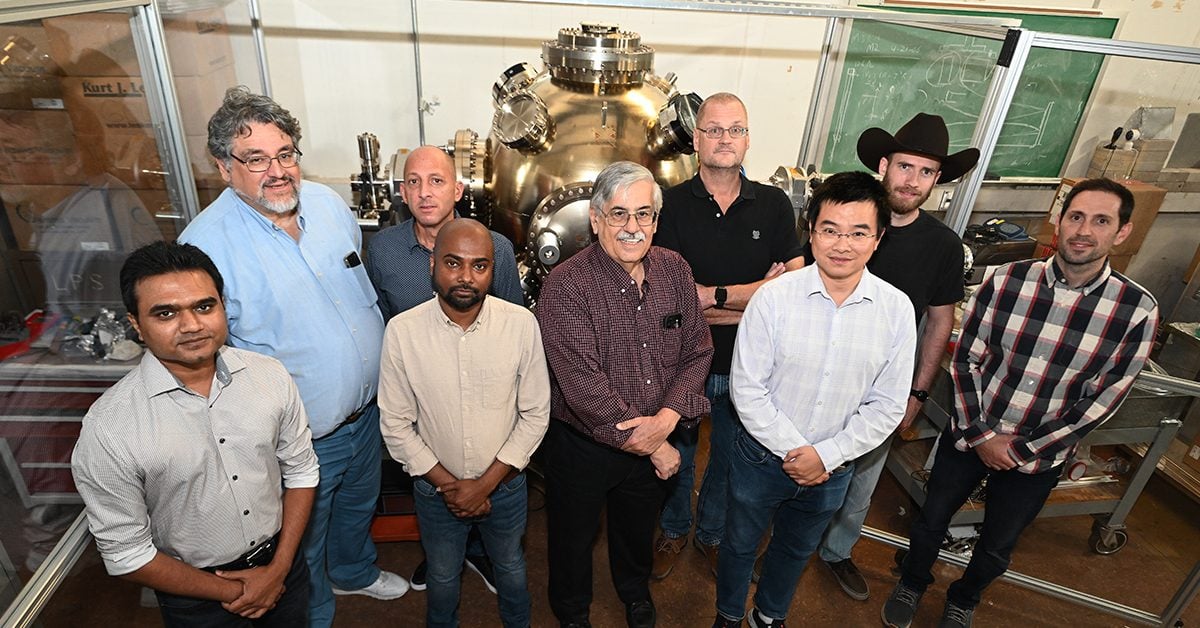
Brookhaven National Laboratory (BNL) scientists have reached a major developmental milestone in the creation of the world’s first fully polarized Electron-Ion Collider (EIC). This recent success is marked by the successful performance of the high-voltage polarized photocathode gun that will be responsible for generating one of the collider’s polarized streams. A main component of the gun’s construction is a custom-designed spherical vacuum chamber manufactured by ANCORP to meet the demanding vacuum needs of the system.
Top image: Part of the team that designed and tested the high-voltage polarized electron gun, left to right: Jyoti Biswas, accelerator physicist, Electron-Ion Collider (EIC); John Skaritka, mechanical engineer, Collider-Accelerator Department (C-AD); Ronald Napoli, Technician, C-AD; Omer Rahman, accelerator physicist, C-AD; Bob Lambiase, electrical engineer, C-AD; Christopher Degen, software engineer, C-AD; Erdong Wang, accelerator physicist, EIC, Patrick Inacker-Mix, laser engineer, C-AD; Matthew Paniccia, electrical engineer, C-AD. (Kevin Coughlin/Brookhaven National Laboratory)
The Integral UHV Chamber and the Electron Beam
Within the system created for the EIC, a cone-shaped high-voltage feedthrough connector delivers current to the gun. Here, laser photons will interact with a gallium-arsenide photocathode, emitting electrons that flow from the cathode to the anode, emerging as a highly polarized electron beam. Due to the ability of the gallium-arsenide layers to quickly degrade, a vacuum chamber was required to protect the material from the presence of residual gases. The design and requirements for this specialized chamber were designed and then brought to ANCORP to bring to life.
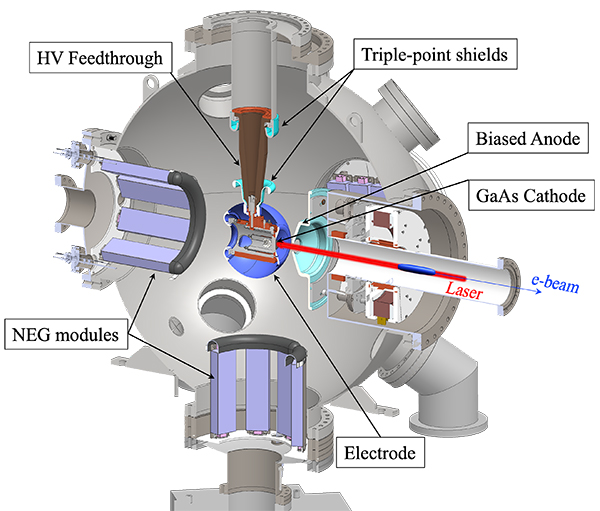
Polarized electron gun: The cone-shaped high-voltage (HV) feedthrough connector delivers current to gun. When laser photons strike the gallium-arsenide (GaAs) photocathode, emitted electrons flow from cathode to anode and out of the gun as a highly polarized electron beam (e-beam). (Erdong Wang/Brookhaven National Laboratory)
Due to the closed nature of the environment required to preserve the photocathode, BNL also had to design new ways of delivering power to the system. The result is a custom-built 36-inch spherical chamber featuring multiple ports to accommodate viewports, standard and nonstandard flanges, and advanced power delivery systems—all while sustaining pressures in the ultra-high vacuum range.
During its construction, ANCORP welcomed BNL researchers into our facility to review the process and perform preliminary tests. Following a comprehensive tour of our production areas, our BNL guests participated in a system-level review of the chamber’s build, including an in-person evaluation of flange surfaces, port configurations, and component fit. The chamber underwent rigorous ultra-sonic cleaning protocols and a residual gas analysis scan to verify its performance capability in ultra-high vacuum conditions. These collaborative touchpoints helped ensure the final product met the strict cleanliness, compatibility, and performance standards required for housing the sensitive photocathode.
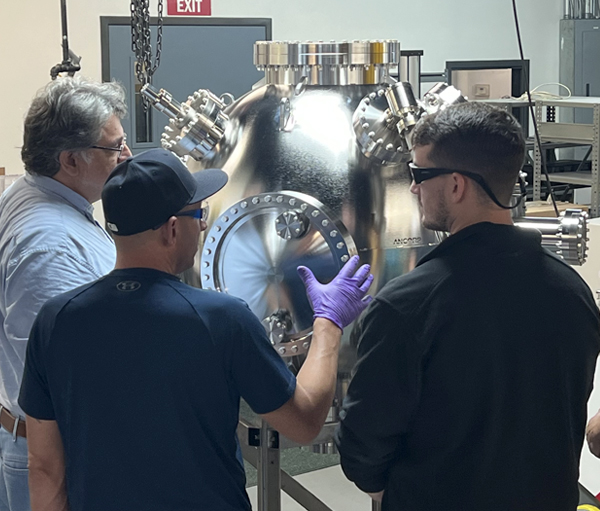
Spherical Chamber Designs
The 36-inch spherical vacuum chamber developed for Brookhaven National Laboratory is a strong example of how spherical geometry can support complex, high-performance beamline systems.
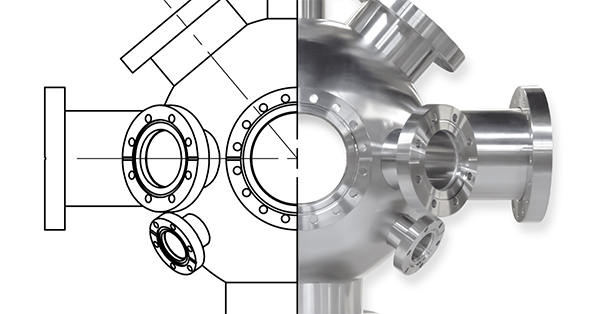
Spherical vacuum chambers are often chosen for systems that require precise radial alignment around a central focal point. Their symmetrical design allows uniform delivery and collection of particles, radiation, or analytical signals, making them well-suited for advanced applications like Pulsed Laser Deposition (PLD), surface analysis techniques such as XPS and AES, and source-target experiments where concentrated interaction is key.
Beyond the mechanical advantages, the spherical form offers a high volume-to-surface-area ratio, providing a large internal workspace while minimizing surface interactions that could compromise vacuum conditions. In BNL’s case, this geometry helped protect the sensitive gallium arsenide photocathode by minimizing residual gas exposure and enabling flexible port integration for their power delivery setup.
The Importance of the Electron-Ion Collider
While particle colliders are not new to the field of nuclear physics, Brookhaven’s Electron Ion Collider will be the first to be fully polarized. This will allow scientists to control the spin, or electromagnetic alignment, of the subatomic particles that make up the beams.
In most education settings, we learn that the smallest subatomic particles of matter are neutrons, protons, and electrons. And for many applications, the explanation holds. But, as the field of nuclear physics continues to develop, researchers discover that even these building blocks have building blocks – gluons and quarks.
By dictating the spin of proton and electron beams through the EIC, researchers can begin to answer some long-standing questions on the nature and interactions of gluons and quarks. Questions whose answers will lead to a greater understanding of the emergence of mass, gluon saturation and origin of proton. With fully polarized collisions, researchers can explore the quantum structure of matter in greater detail in the hopes that light will be shed on the invisible forces that shape our universe at its most fundamental level.
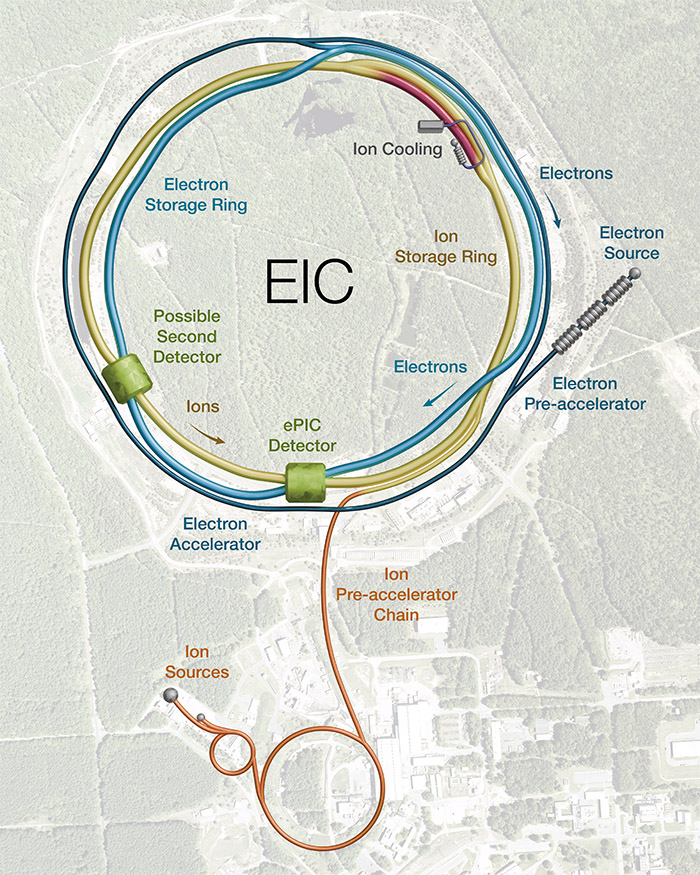
EIC schematic: This graphic shows the location of the photocathode electron gun (Electron Source) that will produce the electron beam that enters the electron accelerator and storage rings for collisions with protons or ions traveling in the opposite direction. (Valerie Lentz/Brookhaven National Laboratory)
Impact of Brookhaven National Lab
The EIC is an incredible accomplishment from the Brookhaven National Lab that will fuel groundbreaking research. However, it is far from being the singular shining achievement produced by the lab. Brookhaven National Lab is world-renowned for pioneering contributions that impact fields such as technology, energy, medicine, medical imaging, the environment, and, of course, physics.
Some of the most recognizable advancements from the lab in the medical field are DNA sequencing, the synthesis of human insulin, Parkinson’s treatment, PET scanning, and the Lyme disease vaccine. BNL is also responsible for advancing modern rail transportation by creating the MagLev technology that powers high-speed rails seen in Germany and Japan today.
If your project involves similar performance needs, reach out to our technical sales engineers to begin bringing your design to life. Or, refer to our Spherical Vacuum Chamber guide to help specify your build with an eight-page guide to design best practices.
Interest in learning more about the EIC build and photocathode gun development can be found through the BNL newsroom or in their published article highlighting its success, “High-Voltage Gun Accelerates Electrons from Zero to 80 … Percent the Speed of Light“.
